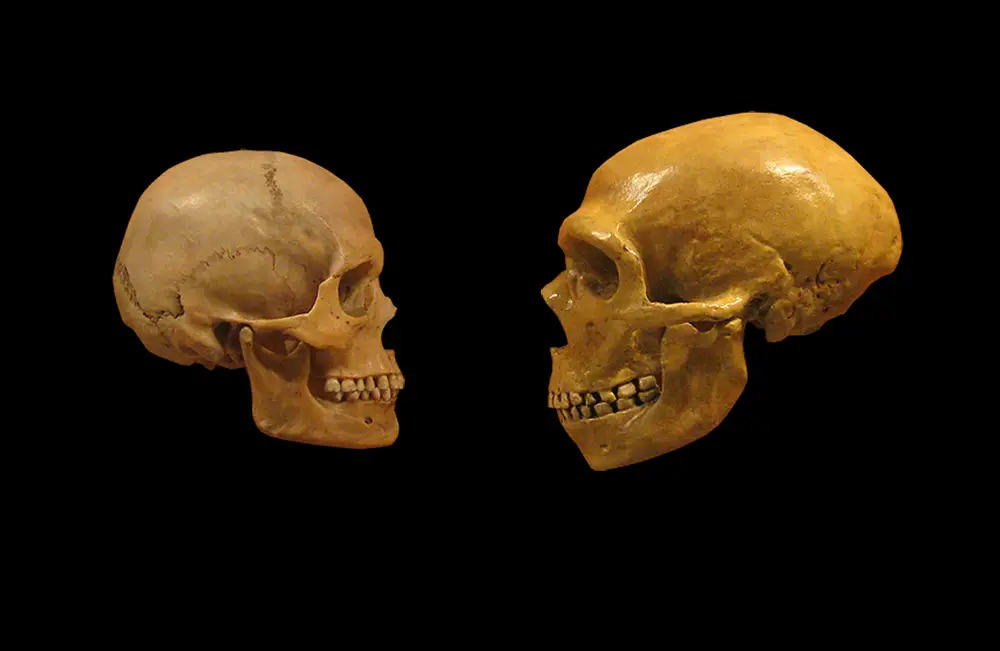Technology boom 50,000 years ago is associated with apparent reduction in testosterone.
Modern humans first appeared in the fossil record approximately 200,000 years ago, however it was only approximately 50,000 years ago that creating art and the construction of advanced tools became widespread.
A new study appearing August 1st 2014 in the journal Current Anthropology finds that human skulls altered in ways that are indicative of lowering testosterone levels at around the same time that culture began to blossom.
“The modern human behaviors of technological innovation, making art and rapid cultural exchange probably came at the same time that we developed a more cooperative temperament,” said lead author Robert Cieri, a biology graduate student from the University of Utah who began his work as a senior at Duke University.
The study is based on the measurements of more than 1,400 ancient and modern skulls and instigates the argument that human society advanced when people began being nicer to each other. This suggests having a little less testosterone was in action.
Heavy brows were filtered out, rounder heads were filtered in, and those changes can be linked directly to testosterone levels acting on the skeleton, according to Duke’s anthropologist Steven Churchill, Cleri’s supervisor on his work on a senior honors thesis that expanded to become the 24-page journal article three years later.
What cannot be distinguished from the bones is whether these humans had less testosterone in circulation, or fewer receptors for the hormone.

The research team also included Duke animal cognition researchers Brian Hare and Jingzhi Tan, who state that the argument presented is in line with what has already been established with non-human species.
In a study of Siberian foxes, animals that were less wary and less aggressive towards humans were of a more juvenile appearance and behavior after several generations of selective breeding.
“If we’re seeing a process that leads to these changes in other animals, it might help explain who we are and how we got to be this way,” said Hare, who also studies the differences between our close ape relatives- the aggressive chimpanzees and mellow bonobos.
These two apes develop very differently, said Hare, as they respond to social stress differently. Chimpanzee males experience a rise in testosterone during puberty, whereas bonobos do not. When stressed, the bonobos do not produce more testosterone, but they do produce more cortisol, which is known to be the stress hormone.
Their social interactions are profoundly different and in relation to this study, their faces are different also. “It’s very hard to find a brow-ridge in a bonobo,” Hare said.
Cieri compared the brow ridge, facial shape and interior volume of 13 modern human skulls older than 80,000 years, 41 skulls from 10,000 to 38,000 years ago, and a global sample of 1,367 20th century skulls from 30 different ethnic populations.
The trend that was revealed was toward a reduction in the brow ridge and a shortening of the upper face, traits that usually reflect a reduction in the action of testosterone.
There are many theories about why, after 150,000 years of existence, humans very suddenly leapt forward in technology. Around 50,000 years ago, there is widespread evidence of the production of bone and antler tools, heat-treated and flaked flint, projectile weapons, grindstones, fishing and birding equipment and the command of fire. The question is; was this driven by a brain mutation, cooked foods, the advent of language, or simply population density?
The Duke study implies that living and cooperating together put a price on agreeableness and lowered aggression and that, in turn, lead to changed faces and more cultural exchange.
“If prehistoric people began living closer together and passing down new technologies, they’d have to be tolerant of each other,” Cieri said. “The key to our success is the ability to cooperate and get along and learn from one another.”
Contributing Source: Duke University
Header Image Source: Wikimedia






